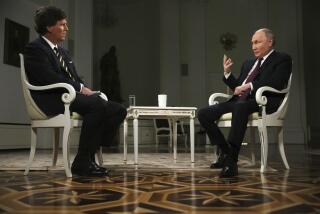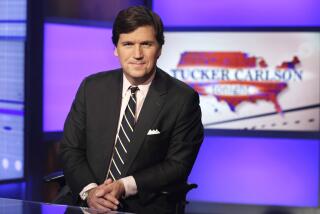Summit Coverage Erases Generations of Red-Bashing Images
- Share via
The Moscow summit capped off the most prolific public-relations blitz in history, a week of historic media coverage that is bound to further soften American views of the Soviet Union.
Nearly erased in one enthralling television sweep were ugly images of Red-bashing Rambo, Russky stereotypes and the Cold War. Viewed even in small segments, the coverage may have eclipsed memories of Stalin’s murders, Khrushchev’s missiles in Cuba, brutal suppression of East Europeans, the invasion of Afghanistan and all the other naughty Soviet deeds that have made Westerners frown.
Not that the bad things weren’t frequently noted by TV reporters, only that they paled against pictures of Soviet citizens basking in new freedoms and a smiling, glad-handing Kremlin leader that you wanted to invite home for dinner.
Encouraged by glasnost , American TV embraced and superbly captured a Soviet Union in transition, footnoting a moment in time that may dramatically affect nuclear disarmament and East-West relations.
A meltdown of American public opinion about the Kremlin has been under way throughout the brief Gorbachev era, with such beaming Soviet faces as commentator Vladimir Pozner becoming almost as familiar on TV here as Ronald Reagan. But each new TV picture this week was worth a thousand Pozners.
Some of the summit’s most profound pictures were unavailable to American viewers, however. They were available on “Vremya,” the main Soviet newscast whose daily summit coverage was aired and reviewed this week on cable’s Discovery channel, with Hodding Carter as host.
Take Tuesday, for example, when Soviet leader Mikhail Gorbachev took President Reagan on an extended tour of the Kremlin grounds. Enveloped by media, they shook hands and chatted with carefully selected average Soviet citizens.
Viewers of American newscasts saw brief excerpts of Reagan and Gorbachev together, more or less as equals. At one point on “The CBS Evening News,” the President was shown gesturing to Gorbachev as they walked briskly, with Reagan appearing alert and commanding. Then it was quickly on to another summit sidelight.
The estimated 150 million “Vremya” viewers saw another Reagan, and it was a devastating picture.
The Soviet newscast stayed with the two leaders for 15 minutes as they strolled through the Kremlin, during which an energetic, animated and talkative Gorbachev completely overshadowed Reagan, who seemed tired, passive and almost uninvolved. Gorbachev even attempted to perk up Reagan and draw him out as they were greeted by some Soviet citizens on Red Square. Then, and only then, did Reagan put his arm around Gorbachev’s shoulder for that picture that American TV audiences saw.
There’s no telling whether “Vremya” purposely ran the longer account to make Reagan look bad. But it was a revealing strip of TV in which reality and the popular caricature of Ronald Reagan as sleepy and unalert merged frighteningly. If nothing else, this Ronald Reagan was not the Reagan that his aides were describing as talking tough with Gorbachev in their private meetings.
The American networks that night did show Reagan nodding off during a speech (which “Vremya” mercifully didn’t show), and NBC’s Chris Wallace reported Wednesday that Reagan’s “lack of vigor has been a story at this summit.” Even under glasnost, “Vremya” is still an arm of the state that distorts the news as the Kremlin sees fit and is in no way comparable to American newscasts in scope or objectivity. As someone put it, American TV may sometimes reflect the government line, but “Vremya” is the government line.
As coverage of the Reagan-Gorbachev stroll shows, however, network newscasts have their own built-in distortion resulting from the rigid time limits imposed on them.
On Monday and Tuesday, for example, “Vremya” was doubled in length to 40 minutes to accommodate summit coverage. ABC, CBS and NBC aired their usual 22-minute newscasts throughout the week, bursting with summit news with usually less than three minutes left over for droppings from the rest of the world. In fact, Monday’s edition of “The CBS Evening News” blew its entire 22 minutes on the summit.
Gorbachev’s wife, Raisa, got almost as much coverage on “Vremya” each night as she got on American TV, a sharp departure from the Soviet tradition of ignoring the wives of top Kremlin leaders.
The Soviet newscast offered a much milder version of the so-called tiff that Raisa Gorbachev and Nancy Reagan had Wednesday at the Tretyakov Gallery in Moscow, where the two women briefly clashed after the American First Lady and her entourage arrived later than expected.
“The lid is off!” ABC’s Peter Jennings reported about the reported feud. But “Vremya” coverage of the gallery tour omitted the acrimony, mentioning only “disappointment” that the Americans “sharply cut back” their time at the gallery.
Personalities did dominate the summit news.
If the Soviets had their own cult of the personality in Gorbachev, meanwhile, so did the United States--in Dan Rather.
“The CBS Evening News” became the “CBS Evening Dan” this week. He was everywhere, anchoring, chatting with Charles Kuralt, interviewing his own correspondents and even Gorbachev. Sort of.
That was Tuesday, when Rather announced at the top of his newscast: “Mikhail Gorbachev talks up prospects for a fifth summit as we talk face to face with the Soviet general secretary in Cathedral Square inside the Kremlin.”
Rather happened to be there preparing his evening newscast when Gorbachev and his entourage came through, shaking hands and getting seen. Cut to Rather, a face in the crowd, speaking to Gorbachev: “I’m Dan Rather with CBS News. I saw you in Washington. I’m pleased to see you again.”
What followed on the air were some perfunctory questions followed by the usual answers. The news on CBS was not what Gorbachev said to Rather, which wasn’t much, but that Rather interviewed him. And, of course, that Rather was pleased to see Gorbachev again.
On Wednesday, meanwhile, NBC threw a question at Gorbachev on the run, and “Vremya” showed a Brazilian TV reporter having an extended interview with Gorbachev in Cathedral Square.
At least these were face-to-face talks. Much of the information reaching viewers via American TV seemed to be educated guesswork cloaked as fact. “The bottom line is that it was good for Gorbachev,” NBC’s Tom Brokaw headlined his Wednesday newscast on the summit. The bottom line is that no one knows that with certainty but Kremlin insiders.
When it came to Gorbachev’s wife, moreover, Rather echoed other reporters when he said: “There’s no doubt Raisa Gorbachev is a tremendous influence” on her husband. But how does Rather or anyone else outside Gorbachev’s inner circle know that? And what about those reporters insisting that Reagan and Gorbachev got along so well? And other reporters saying Reagan was no patsy with Gorbachev.
“All they know is what spin merchants tell them,” Carter, a former spin merchant himself as State Department spokesman under President Carter, said by telephone from Washington. “Beyond that, they don’t know anything.”
More to Read
Sign up for Essential California
The most important California stories and recommendations in your inbox every morning.
You may occasionally receive promotional content from the Los Angeles Times.













